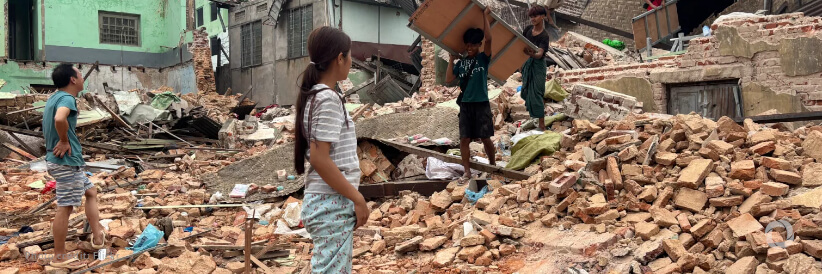One month after the devastating 7.7 magnitude earthquake that struck central Myanmar on 28 March 2025, humanitarian needs continue to be immense in a country that is both grieving and grappling with new threats, with the imminent arrival of the cyclone and monsoon seasons.
The IFRC, Myanmar Red Cross Society (MRCS), and Red Cross and Crescent partners continue to work intensively at the heart of the communities most affected to ensure critical needs are met.
Conditions on the ground continue to be very challenging. More than 50,000 buildings have been destroyed, and many more have partially collapsed or are at risk of collapse. Over 198,000 people have been displaced and continue to live outdoors in temperatures of up to forty degrees Celsius, living with an overwhelming fear of further aftershocks. Myanmar’s cyclone season starts within days, exposing coastal populations to strong winds and rains, leaving families to face the risks of floods, landslides, and extreme heat.
Immediate humanitarian aid remains vital, with IFRC’s efforts also now shifting to focus on early recovery needs. This includes access to more permanent shelter with people’s basic needs being met, as well as sustainable access to water and sanitation, and support to help restore shattered livelihoods. These medium and longer-term needs are becoming an important focus of IFRC’s efforts, working alongside the Myanmar Red Cross Society and Red Cross and Crescent partners, including the International Committee of the Red Cross (ICRC).
The sheer geographical scale and magnitude of the disaster, with over 1.3 million people affected over five states and regions of the country, means more international funding is urgently needed.
The IFRC launched a 100 million Swiss Francs Emergency Appeal in the immediate aftermath of the disaster, most of which will be invested over two years to reach 100,000 people. This, in a country where people have faced multiple shocks in recent years, including unprecedented floods only seven months ago and ongoing hostilities. But to date, this IFRC appeal is only 15% funded, leaving a massive gap.
IFRC and MRCS have been active since day one and are continuing to provide comprehensive humanitarian services in Bago, Mandalay, Naypyidaw, Sagaing, and Southern Shan. The MRCS has access to the vast majority of the areas impacted by the earthquake and has conducted rapid needs assessments with the IFRC and in coordination with humanitarian agencies. The main needs identified are healthcare, shelter, food, water, and sanitation, providing cash and emergency relief items, while addressing specific needs of the young, elderly, or disabled.
MRCS has reached over 84,000 people with assistance to date. Over 20,000 litres of clean drinking water are being distributed daily, and 250 metric tonnes of relief items have arrived in the country. The IFRC has also deployed 24 Rapid Response personnel from its network of Red Cross and Red Crescent Societies – some 65 per cent of whom are women. But while immediate needs remain critical, Myanmar’s recovery will be a long road, with strong international support needed in the months ahead.
“Initial assistance and comprehensive coverage of needs are essential to enable people to begin rebuilding their lives and livelihoods in a context where time is of the essence. Before the earthquake, the Myanmar Red Cross was already present in so much of the affected areas and will continue to remain present – assisting communities in temporary camps, monasteries, mosques, and churches. Its inspiring and dedicated volunteers have the trust, reach and local knowledge to make a real difference in affected communities. But this is not only about immediate needs – the road to recovery for these populations will be long. Investment is critical, not just for today but for the future,” said Nadia Khoury, Head of Delegation of the IFRC in Myanmar.
The recovery work constitutes the bulk of the CHF 100 million appeal. This includes restoring livelihoods and community resilience – cash and voucher assistance, transitional shelter, sanitation, agricultural support, and vocational training. Community-based disaster risk reduction, addressing public health in emergencies, rehabilitation of community infrastructure such as clinics, schools, and access to water, will also be planned through investment in national humanitarian actors such as the Myanmar Red Cross, who can provide the most effective and impactful humanitarian assistance.
IFRC thanks its donors and its member Red Cross Red Crescent Societies for their valued support through in-kind resources and funding. IFRC continues to call on donors, partners, and the international community to provide support to meet the needs of the people of Myanmar, now and in the months ahead.

